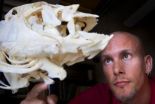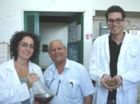(Press-News.org)
VIDEO:
Brown University evolutionary biologist Nicolai Konow led a team that has teased out the difference in chewing between fish and mammals. Now, the question is where, and with which species,...
Click here for more information.
PROVIDENCE, R.I. [Brown University] — Evolution has made its mark — large and small — in innumerable patterns of life. New research from Brown University shows chewing has evolved too.
Researchers looked at muscles that control the movement of the jaw and tongue in fish and in mammals. They learned that fish use tongue muscles primarily to funnel the food farther into the mouth for processing, as if the morsel were an object in an assembly line. Mammals use tongue muscles to position the food, so that jaw muscles can best use teeth to chew the food.
The difference in chewing shows that animals have changed the way they chew and digest their food and that evolution must have played a role.
"It's pretty clear that all of these animals chew, but the involvement of the tongue in chewing differs," said Nicolai Konow, a postdoctoral researcher at Brown and the lead author on the study, published in the journal of Integrative and Comparative Biology. "And that brings up the question of what the muscles associated with the tongue and the jaw are doing."
In 2008 and last year, Konow and colleagues published papers showing the chewing technique of bowfin, pike, and fish with tiny teeth on their tongues, such as salmon and osteoglossomorphs (fish with bony tongues). In some of these species, the researchers showed that chewing begins with the tongue positioned in the upper mouth. Then the fish fires the muscle, called the sternohyoid, downward, retracting the tongue inward, before moving it forward again, and upward, to its original position in the upper mouth. With the fish facing left, the chewing cycle looks like an ellipse tilted at an angle, with the tongue moving in a clockwise direction.
The finding was bolstered by earlier research by other scientists that showed the same chewing pattern in other fish, including bichir (a freshwater fish in Africa), gar, and, importantly, lungfish, which is believed to represent an early stage in the transition of some species from exclusively water- to land-dwelling.
In this paper, Konow and his team studied how the muscles of three mammals acted during chewing: alpacas, goats, and pigs. They outfitted each with electrodes planted in the jaw and tongue muscles to pinpoint the activity of each set of muscles during chewing. The analysis indicated that the animals' tongues thrust forward, and upward, as they began to chew and then fell back, or retracted, to their original position. With the animals facing left, the tongue traces an ellipse in a counter-clockwise direction for each cycle.
The distinction between fish and mammal chewing is likely there for a reason, Konow said. With fish, the tongue's function is to transport the food quickly into and through the mouth, where, in many species, an extra set (or sets) of jaws will grind the food. In addition, the tongue moves oxygenated water through the mouth to the gills, helping the fish to breathe.
"That's why you want to constantly have that inward movement with the tongue," Konow explained.
Mammals, on the other hand, use their tongues to set the food in the right spot in the mouth to maximize chewing. But even among closely related species, there is a surprising difference: Herbivores, such as alpacas and goats, were less coordinated during chewing than omnivores, represented by the pigs. Cud-chewing animals were not as monotonously rhythmic in their chewing as many would believe.
"It is a puzzling finding," Konow said. "We think the herbivore needs the bolus (the soft mass of chewed food) to be in a precise place between each chew. So the tongue may be constantly moving around to make sure the bolus is in the right place between chews."
Next came the task of figuring out where, when and with what species the divergence in chewing emerged. Previous research by Anthony Herrel, a Belgian biologist now based at the Museum National D'Histoire Naturelle in Paris, showed that lizards fire their tongues forward and upward as they begin chewing, just like mammals. The thinking is that the transition likely occurred among amphibians. That makes sense, Konow said, and he plans to look next at amphibian chewing. "They're still locked to the water for reproduction," he said. "But you have some that become all terrestrial. And that's the next step on the evolutionary ladder."
INFORMATION:
Contributing authors include Herrel; Callum Ross from the University of Chicago; Susan Williams from Ohio University; Rebecca German from Johns Hopkins University; and Christopher Sanford and Chris Gintof from Hofstra University.
The U.S. National Institutes of Health and the U.S. National Science Foundation funded the research.
Tongue makes the difference in how fish and mammals chew
2011-06-28
ELSE PRESS RELEASES FROM THIS DATE:
Rodrigo Cigars Selects Simply-Bookkeeping to Manage Its Accounting and Bookkeeping Back-Office Operations
2011-06-28
Simply-Bookkeeping, a Houston, TX based Accounting and Bookkeeping Company; today announced the signing of its newest client, Rodrigo Cigars, a manufacturer of the finest ultra premium Dominican Republic Cigars. Rodrigo Cigar's will retain Simply-Bookkeeping services to optimize and manage the company's financial back-office accounting operations.
"We are very excited about beginning this partnership with Rodrigo Cigars," said Reanna Q Hong, Managing Partner of Simply-Bookkeeping. "Their dedication to the art of crafting the finest cigars is extremely ...
UCI, French researchers find master switch for adult epilepsy
2011-06-28
Irvine, Calif., June 27, 2011 – UC Irvine and French researchers have identified a central switch responsible for the transformation of healthy brain cells into epileptic ones, opening the way to both treat and prevent temporal lobe epilepsy.
Epilepsy affects 1 to 2 percent of the world's population, and TLE is the most common form of the disorder in adults. Among adult neurologic conditions, only migraine headaches are more prevalent. TLE is resistant to treatment in 30 percent of cases.
UCI neurologist and neuroscientist Dr. Tallie Z. Baram and her colleagues found ...
Diane Fanning's Twisted Reason Launches July 1, 2011
2011-06-28
Known as one of the "elite" authors in the true crime genre, and recently for MOMMY'S LITTLE GIRL, recounting the true story of the life and death of 2 year old, Caylee Anthony, Diane Fanning's fourth book in her crime mystery series, TWISTED REASON, is scheduled to be released in trade paperback July 1, 2011. The Lucinda Pierce Mystery series debuted in 2008 with the release of THE TROPHY EXCHANGE and features Virginia Homicide Detective Lucinda Pierce as she follows the evidence and investigates murders.
TWISTED REASON follows Lucinda Pierce as she works ...
Parent-adolescent cell phone conversations reveal a lot about the relationship
2011-06-28
New Rochelle, NY, June 27, 2011—The nature of cell phone communication between a parent and adolescent child can affect the quality of their relationship, and much depends on who initiates the call and the purpose and tone of the conversation, according to an illuminating study reported online in Cyberpsychology, Behavior, and Social Networking, a peer-reviewed journal published by Mary Ann Liebert, Inc. (www.liebertpub.com). The article is available free online at http://www.liebertpub.com/cyber
Robert Weisskirch, MSW, PhD, California State University, Monterey Bay ...
El Paso Cosmetology School Says Thank You to Military Personnel and Their Families
2011-06-28
Military personnel, their parents, siblings and children can receive 50% off of any service and 20% off Peter Hantz, Asazi, eXo and Madrid's products July 1st and 2nd at ITS Academy of Beauty, 750 Sunland Park Drive in El Paso.
To participate in the career college's Patriotic Beauty campaign, patrons must show military I.D. or some sort of physical proof such as an email, letter or photograph to prove their spouse, son or daughter or sibling is serving in the U.S. military.
"We really wanted to do something special to honor our troops, as well as the families ...
Alzheimer's prevention in your pantry
2011-06-28
Alzheimer's, the degenerative brain disorder that disrupts memory, thought and behavior, is devastating to both patients and loved ones. According to the Alzheimer's Association, one in eight Americans over the age of 65 suffers from the disease. Now Tel Aviv University has discovered that an everyday spice in your kitchen cupboard could hold the key to Alzheimer's prevention.
An extract found in cinnamon bark, called CEppt, contains properties that can inhibit the development of the disease, according to Prof. Michael Ovadia of the Department of Zoology at Tel Aviv ...
Critically Acclaimed 'The Den of the Assassin' By Geopolitical Novelist Peter Thomas Senese To Be Released in E-Book July 14th, 2011
2011-06-28
Author Peter Thomas Senese is pleased to announce his international espionage thriller titled The Den Of The Assassin will be released in e-book worldwide on July 14th, 2011 and will be available on all e-book platforms.
Critics have praised The Den Of The Assassin as an international financial espionage thriller steeped in the modern-day realities of our world, providing the story a visceral prescience teeming with realism and frightful possibilities of global terrorism, and Senese as a masterful writer of international intrigue.
Peter Thomas Senese commented, ...
Study reveals possible brain damage in young adult binge-drinkers
2011-06-28
It's considered a rite of passage among young people – acting out their independence through heavy, episodic drinking. But a new University of Cincinnati study, the first of its kind nationally, is showing how binge drinking among adolescents and young adults could be causing serious damage to a brain that's still under development at this age.
Researcher Tim McQueeny, a doctoral student in the UC Department of Psychology, is presenting the findings this week at the 34th annual meeting of the Research Society on Alcoholism in Atlanta.
High-resolution brain scans on ...
Newcastle Letting Agents Launch Pad for Growth
2011-06-28
Citypadz, one of the north east's leading property letting agents, has revamped its online marketing strategy.
The new marketing strategy has been as part of a strategic move to raise their profile with audiences across the region and in the rest of the UK. The agency's revitalised marketing approach has seen it redesign its website to improve reader experience and included the development of a presence across social media platforms such as Facebook and Twitter.
These changes reflect the organic growth of the company over the last year, which has seen it expand its ...
Greener disaster alerts
2011-06-28
New software allows wireless sensor networks to run at much lower energy, according to researchers writing in the International Journal of Sensor Networks. The technology could improve efficiency for hurricane and other natural disaster warning systems.
Wireless sensor networks (WSNs) are used to monitor ecosystems, wild and urban environments. They have been vital in predicting events that threaten species and environments, including gathering information from animal habitats, in volcanic activity monitoring, flash-flood alerts and environmental monitoring. Wireless ...


